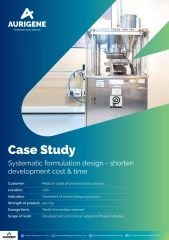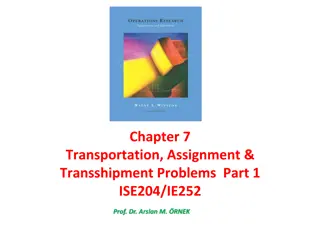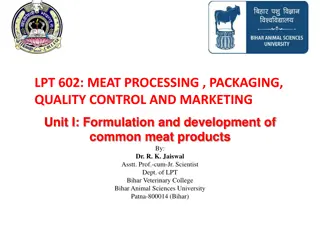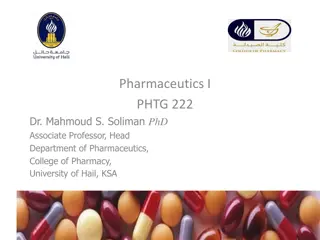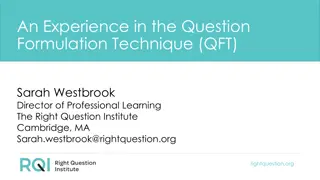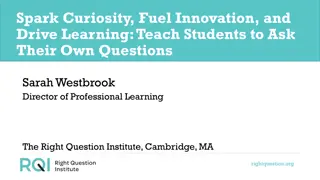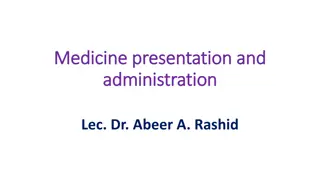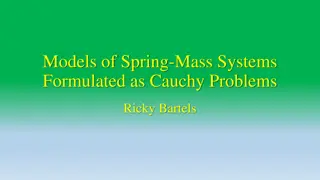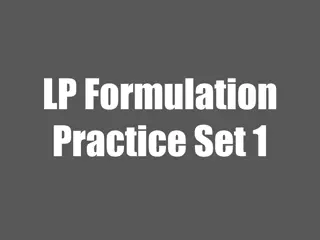Effective Formulation of E-Tivities for Engaging Online Activities
Learn how to effectively formulate engaging e-tivities for online activities by understanding Bloom's Taxonomy, key elements of e-tivities, and exploring examples like the Moodle Forum. Discover strategies to encourage student participation, promote clear task instructions, and foster meaningful dialogue. Improve your e-moderation skills and create impactful learning experiences in virtual classrooms.
Download Presentation

Please find below an Image/Link to download the presentation.
The content on the website is provided AS IS for your information and personal use only. It may not be sold, licensed, or shared on other websites without obtaining consent from the author. Download presentation by click this link. If you encounter any issues during the download, it is possible that the publisher has removed the file from their server.
E N D
Presentation Transcript
ONLINE ACTIVITIES HOW TO EFFECTIVELY FORMULATE E-TIVITIES CC BY 4.0 CC BY 4.0 Manuel Feldbaumer, University of Graz, updated by Manuel Feldbaumer 1
BLOOMS TAXONOMY AND ACTION VERBS FORMULATING clear & specific TASKS Synthesise: Compile, develop, plan, produce, Analyse: Differentiate, identify, order, separate, Apply: complete, examine, modify, predict, prepare, Comprehend: clarify, compare, contrast, summarise, paraphrase, Remember: define, describe, list, Adapted from Anderson & Krathwohl (2001). A Taxonomy for Learning, Teaching, and Assessing. 2
ELEMENTS OF "E-TIVITIES" encourage students to take part in the activity; rather brief Title Purpose explain why activity is important; be transparent Task summary brief and clear instructions; break up longer tasks try to make it as engaging as possible for the students Spark Individual contribution clear instruction what the individual student has to do Dialogue begins clear instruction how students should interact with each other explain what the e-moderator will do; e.g., summarise or give feedback deadline, estimate time required; e.g., expected workload E-moderator interventions Schedule and time Next link to the next e-tivity suggest additional resources Adapted from Gilly Salmon (2013): E-tivitites 3
E-TIVITIES EXAMPLES FOR MOODLE ACTIVITIES 4
Example e-tivity: MOODLE FORUM (1/2) Stimulus In our synchronous session we talked about the importance of e-moderation in a blended learning scenario. We want to give you the chance to reflect on your teaching practices and how e-moderation may have already been part of your teaching anyway. Task(s) Step 1: Have a second look at the slides of our session on e-moderation. In particular, revisethe sections on Gilly Salmon s Five Stage Model (slides 9-18), E-Moderation throughout the term (slides 26-31), and Do s and Don ts of E-Moderation (slides 38- 40). Step 2: Pick out two elements that you find crucial about E-Moderation. Name them and state, why you find them so important for teaching. Also, reflect on how you would like to implement them in your teaching practices or what, if anything, you are already doing. Length: approx. 100 words Form: Create a forum entry in the forum E-Moderation Reflection Forum . You may refer to the training slides for parts of your reflection. Deadline: Tuesday, 18.10., 10:00 (Vilnius Time) 5
Example e-tivity: MOODLE FORUM (2/2) Purpose and learning goals: Understanding that e-moderation is an essential part of any e-learning proportions, where online activities are conducted and managed; acquiring skills to create entries in a subject-based forum; understanding how to provide different forms of online support in the course of a term; reflecting on own teaching practices, in the past and future. Dialogue: Optional: If you want and have time, have a look at your colleagues posts and react to what they had to say about e-moderation and their experiences with it. Schedule and time: Expect to take about 45 minutes to fully revise the material and complete all the tasks. Plan to take 15 minutes to re-read the slides. Even if your reflection is brief, you should choose your words carefully, and engage in reflecting properly. Reading your colleagues entries is not going to be time-consuming, but make sure you encourage critical thinking. 6
Example e-tivity: MOODLE GLOSSARY (1/2) Stimulus In our synchronous and asynchronous sessions as well as the assigned readings, you frequently come across complex and sometimes contested terms, often defined somewhat differently by scholars and teachers. Having already talked about the importance of defining key terminology and theoretical concepts during our synchronous online sessions, let s create a glossary of key terms on remote/blended learning that are important for our future sessions. We will expand this glossary with more terms throughout the semester. Task(s) Step 1: Picktwo terms from the Choice activity list in Moodle (indicated with a green ? symbol). Each term can be selected by one participant. Step 2: Write a comprehensive definition for each of the two terms you chose in the choice activity (i.e. no definitions taken from Urban Dictionary or blogs with authors that use only pseudonyms, etc.). Length: approx. 150 words per definition (plus source references). Form: Create new definition in the glossary Key terms on blended/remote learning . You may use direct quotes for parts of your definition, but it is better to paraphrase and give credit to the author(s) whose thoughts and ideas you have used. You may refer to the training readings for at least parts of your definition, as many of the terms listed are discussed there. Deadline: Thursday, 25.11., 09:45 7
Example e-tivity: MOODLE GLOSSARY (2/2) Step 3: Peer Feedback: Comment briefly on two definitions by your colleagues with a comment in the glossary. Length: not specified. Form: Offer some feedback on whether you think the definition is comprehensive; what, if anything is lacking; whether the sources are adequately referenced; and other aspects you notice. Deadline: Monday, 29.11., 14:45 Purpose and learning goals Understanding that definitions are often complex and depend on one s theoretical and disciplinary background as well as other factors; understanding that the first definition found on Google, on Wikipedia, or in an online dictionary is not always the most useful or comprehensive one and may require critical thinking to arrive at a working definition for a particular context; acquiring skills to create entries in an online glossary; acquiring skills to assess scholarly definitions and give peer feedback. Dialogue Engage with your colleagues by replying to definitions. When giving feedback, follow general conventions on how to do so. Schedule and Time Expect to take about 1 hour to fully engage with the material and complete all the tasks. 8
REFERENCES Literature Anderson, Lorin & Krathwohl, David (2001). A Taxonomy for Learning, Teaching, and Assessing: A Revision of Bloom s Taxonomy of Educational Objectives (2nd ed.). Pearson Education. Salmon, Gilly (n.d.). E-tivitites: Introduction. Gilly Salmon. https://www.gillysalmon.com/e-tivities.html Salmon, Gilly (2013). E-tivitites: The Key to Active Online Learning (2nd ed.). Routledge. Graphics All used graphics are licensed under CC0 1.0 by CocoMaterial logo of CocoMaterial CC BY 4.0 CC BY 4.0 Manuel Feldbaumer, University of Graz, updated by Manuel Feldbaumer 9


